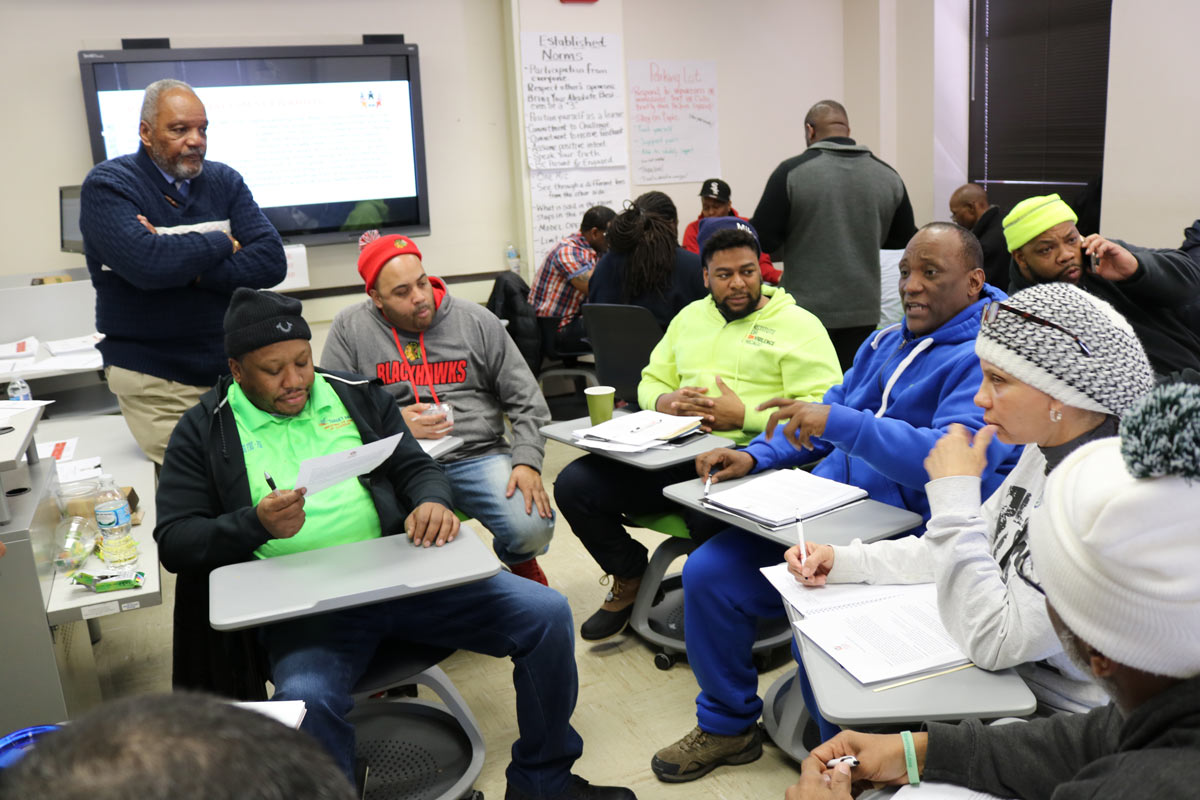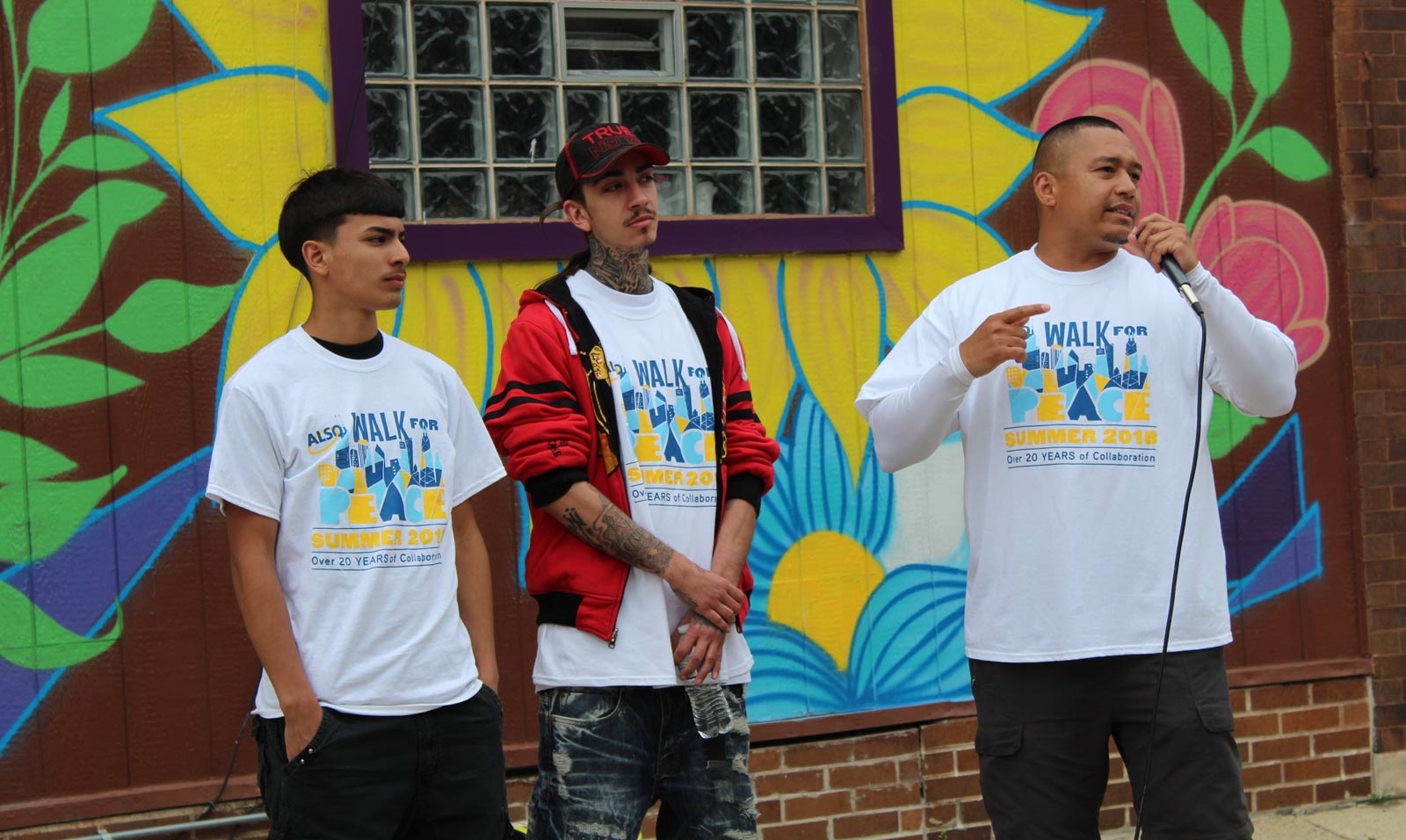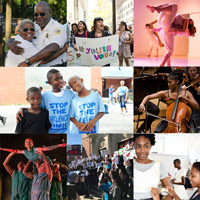Street outreach workers create a new architecture of violence prevention in Chicago, helping build trust, credibility, and respect for the often-dangerous work.
On a corner in West Humboldt Park, a cluster of young men make quick exchanges with a stream of passersby—a common sight in areas of Chicago’s West Side known for open-air drug markets.
Until recently, the young men were on the other side of the street, directly in front of a newly rehabbed building where they were a cause of anxiety and fear for the residents—including single mothers and children—who had recently moved in.
The shift across the street was small, but significant for the neighborhood’s safety—thanks to the intervention and persuasion of Jorge Matos and his team of anti-violence street outreach workers.
The outreach team joined the building tenants and owners for a sidewalk barbecue in June, hamburgers sizzling on the grill and music blasting. Their efforts were another way to create and reclaim safe community spaces on the block—and at least one of the young men crossed the street to join in.
For decades, outreach has been a vital element in efforts to stop Chicago’s cycles of street conflict, as profiled in the 2011 documentary, “The Interrupters.” While many outreach workers have troubled histories of their own—almost all are former members of “street organizations,” the term people in the field prefer to “gangs”—they are now intervening with new tools from Communities Partnering 4 Peace (CP4P), a coalition formed to professionalize the work.
The 2-year-old program offers training and a place to share best practices through an 18-week course at the Metropolitan Peace Academy. The program is geared not only toward refining the sensitive, often-dangerous work of street outreach but also helping build credibility, trust, and mutual respect with law enforcement as Chicagoans attempt to join forces against gun violence.
Seventy people have graduated in three cohorts from the academy, with another 26 starting classes in August.
Past organized street outreach efforts struggled with perceptions that the lines between the workers and street organizations were too fluid and that some were still involved in illegal activities. Uneven funding made it hard to see the work leading to a stable, viable career.
CP4P is financed by the Partnership for Safe and Peaceful Communities, a coalition of more than 40 foundations and funders, which has brought some stability to the field. The Partnership began forming in 2016, originally to support the city’s Police Accountability Task Force. The partnership also supports READI Chicago, which aims to reduce violence by providing young people with paid transitional jobs, cognitive behavioral therapy, and other services.
The funders would like to see the most promising and effective strategies it supports incorporated into the city’s comprehensive anti-violence strategy. Funders hope street outreach receives more official and financial support from the city as Mayor Lori Lightfoot lays out her plan to make the streets safer.
“Now the police know what (the outreach workers) are doing and understand what their goal is, so they can get their work done in a way that doesn’t put them in conflict with law enforcement,” said CP4P director Vaughn Bryant.
Matos, director of the Safe Streets program at ALSO, the Alliance of Local Service Organizations on the West Side, said that previously the work often felt like “two steps forward and four steps back.”
Today, he says, outreach workers “know they’re not going to lose their jobs, so they’re not going to relapse because they’re worried about feeding their family.”

Participants collaborate during a Metropolitan Peace Academy session
The key to the work is deploying credible messengers into the streets, leveraging their connections and past experiences. They often quickly deploy after an outburst of violence to prevent retaliations. But the work also includes steady diplomacy, such as the intervention in West Humboldt Park.
For Matos, 40, the work began after years in prison that started when he was a teenager. A mentor convinced him to try it, and he quickly excelled. He was among the first cohort to graduate from the Peace Academy in 2017.
“When we’re in the community working with young people, we can see those roads that they can’t see,” Matos said. “So, it’s about building relationships and walking with them.”
The academy’s 144-hour curriculum helps participants understand the effects of trauma, sexism, and racism.

Graduates of the Metropolitan Peace Academy at their graduation ceremony
The academy also brings outreach workers together from different organizations across the city. This helps them work together to stem the interpersonal conflicts and rivalries crossing neighborhood boundaries before they escalate, and it helps workers recognize that their communities face the same challenges and need similar solutions. Before, many of the outreach workers did their jobs in isolation.
Among the more than two dozen outreach groups involved are the Institute for Nonviolence Chicago in Austin, Precious Blood Ministry of Reconciliation in Back of the Yards, Inner-City Muslim Action Network in West Englewood, Breakthrough in East Garfield Park, and UCAN in North Lawndale.
A key component of effective outreach is connecting individuals at highest risk with resources—like GED courses, job training, housing, and mental health services. CP4P-supported organizations offer resources directly or refer people to local organizations that offer these critical services.
“You refer them to jobs, go to court with them, just listen to them and talk to them,” said Rodney Phillips, who did outreach on the South Side for Target Area Development Corporation and is now teaching at the Peace Academy. “You’re a mediator, a therapist; you wear a lot of different hats.”
CP4P also sponsors a series of “Light in the Night” events in parks and other public spaces—basketball tournaments, family-oriented games, and other activities that give residents a safe place to hang out together. Since CP4P’s founding in 2017, almost 140,000 people have attended almost 2,500 such events.
A team of Northwestern University researchers led by sociologist Andrew Papachristos is evaluating the program. He said it is impossible to measure the exact impact so far, but there are positive signs: homicides in the first six months of 2019 were at their lowest for the same period since 2016, according to police data, and shootings were at their lowest since 2015, with both showing a steady decline.
Teny Gross, executive director of the Institute for Nonviolence Chicago, said the expanded level of outreach work is part of a “new architecture of violence prevention in Chicago.”
“But we need to stick by it, tweak it, make incremental small improvements,” he said.
Added Chris Patterson, the Institute’s director of programs, “The only answer we’ve had up until this point is incarceration and even the grave.… But it makes a huge difference, the relationship-building with those who are more disenfranchised. This work really affords us an opportunity to save money and save lives."
MacArthur has provided $13.3 million to Partnership for Safe and Peaceful Communities-supported strategies since 2016.
Read More
Building Relationships and Earning Trust to Reduce Gun Violence
Tawa Mitchell, Senior Program Officer, Chicago Commitment




